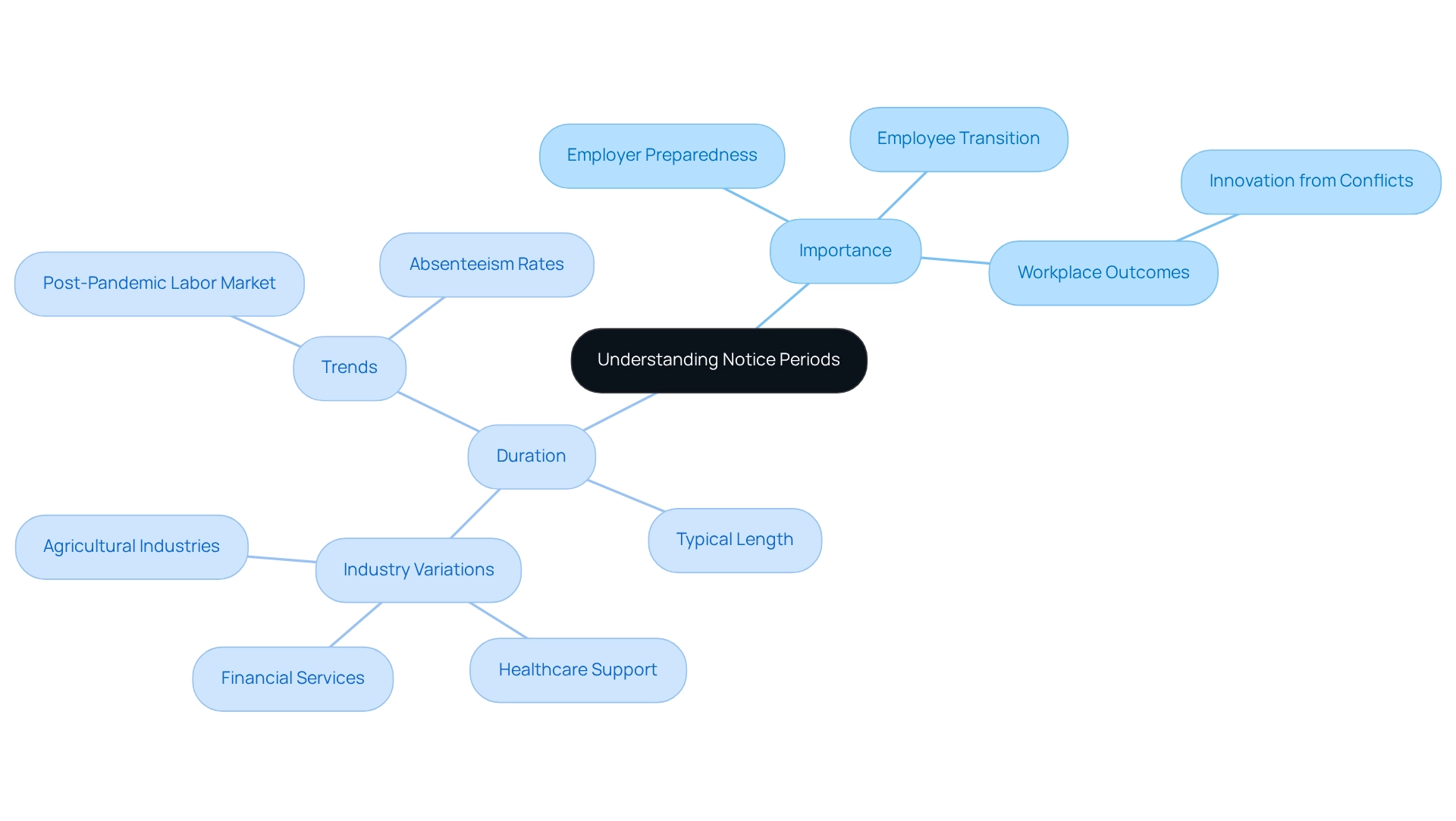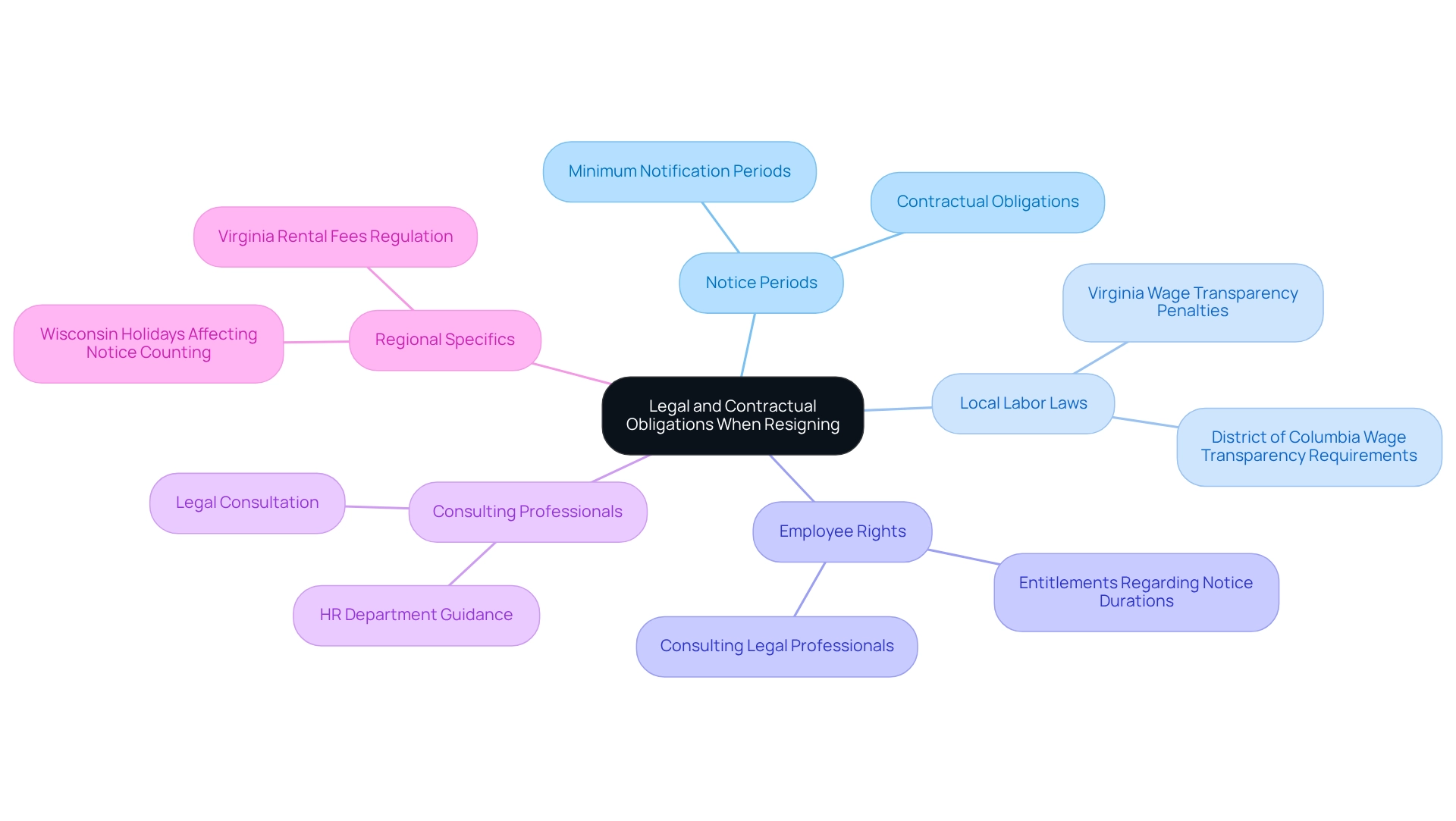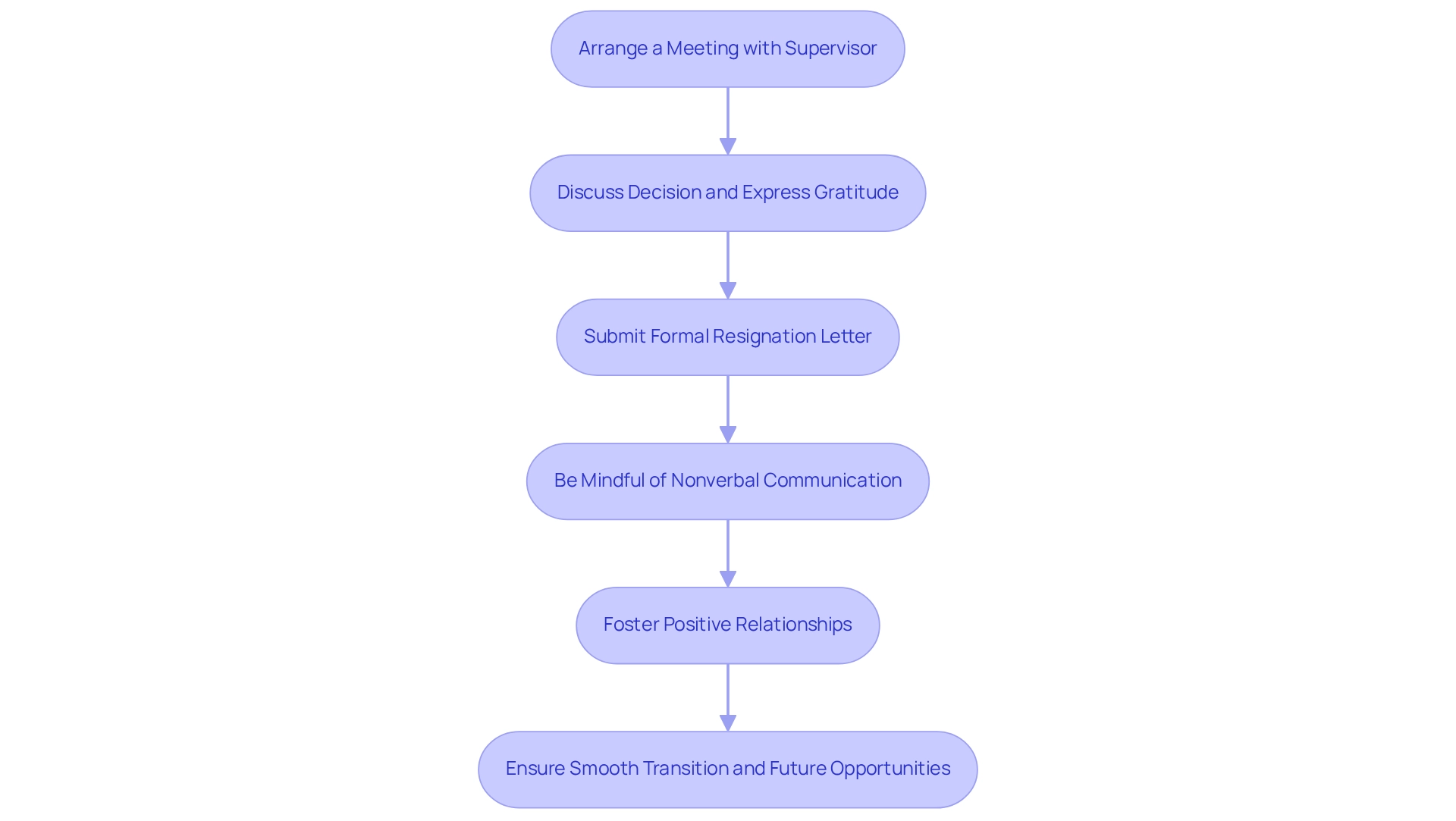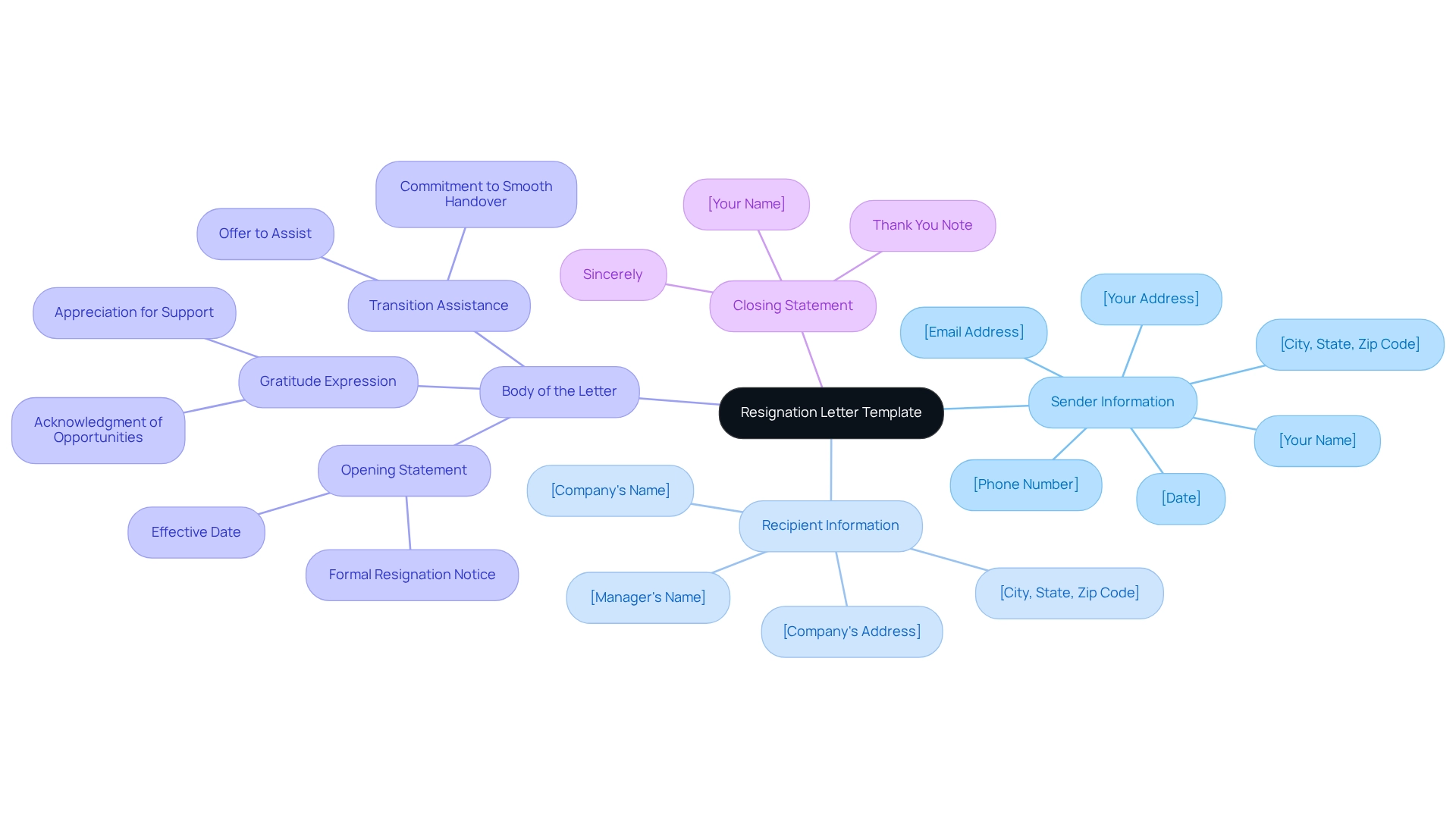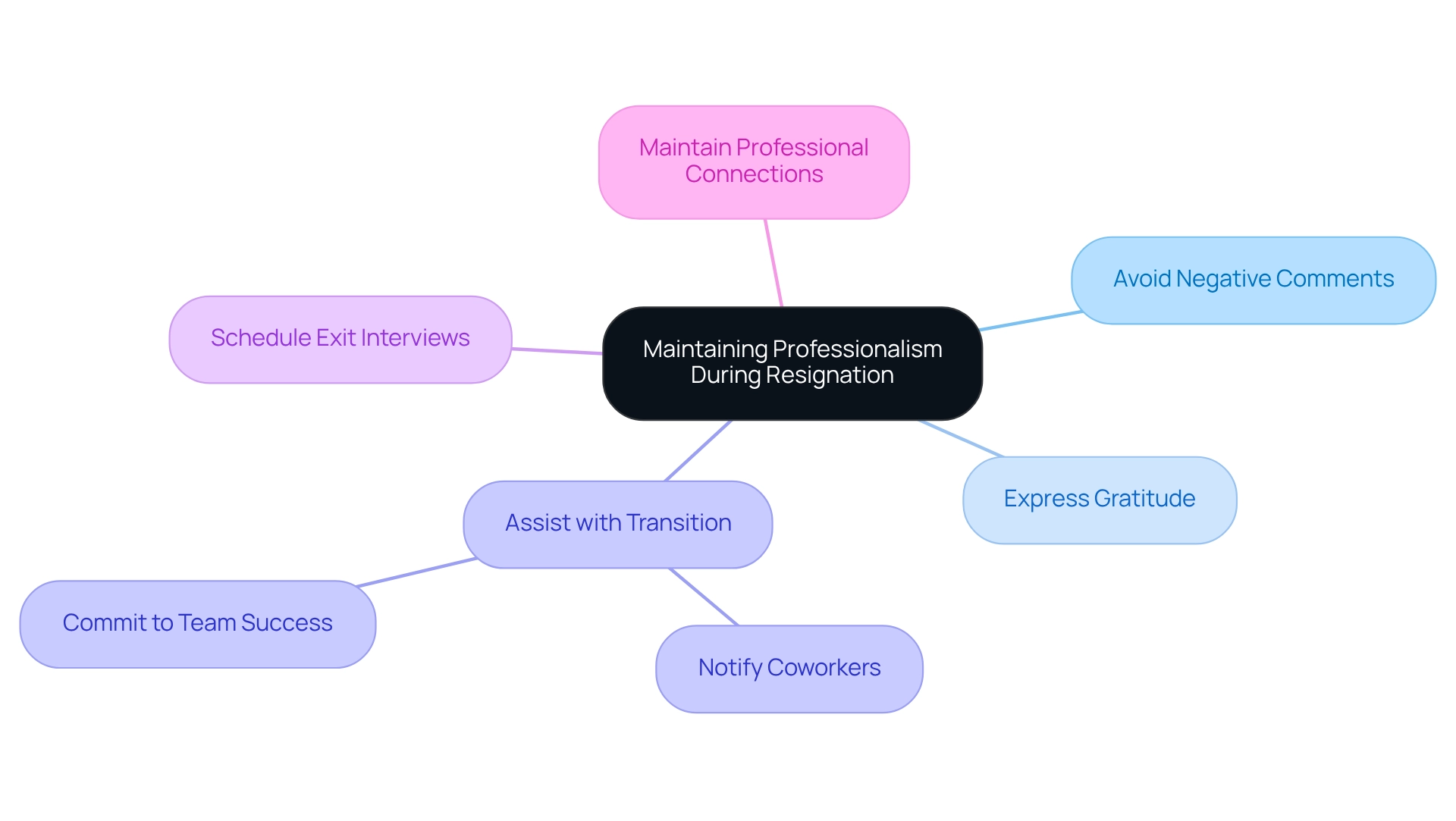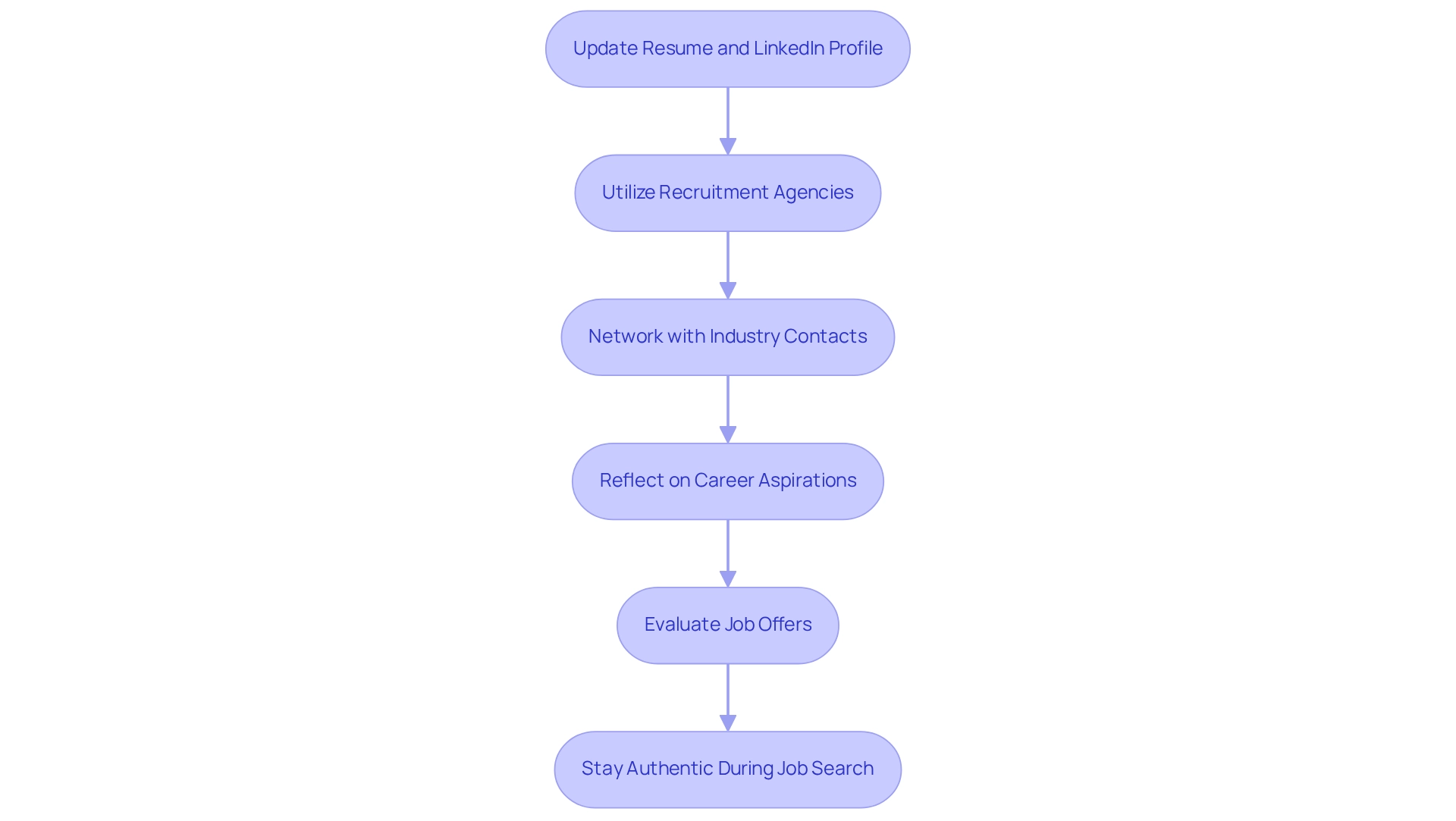Overview
The article serves as an authoritative guide on how to give notice effectively, underscoring the critical role of notice periods, communication, and professionalism throughout the resignation process. It asserts that a well-managed notice period not only facilitates smoother transitions for both employees and employers but also allows ample time for task completion and relationship maintenance. Furthermore, it emphasizes the necessity of understanding legal obligations and effectively communicating one’s decision to resign.
Key Highlights:
- A notice period is the time an employee must continue working after resigning, typically ranging from two weeks to several months.
- Notice periods allow employers to prepare for an employee’s departure and help employees finalize tasks and maintain professional relationships.
- Standard notice duration is two weeks, but senior roles often require longer notice periods, especially in complex sectors like finance.
- The length of notice periods is influenced by factors such as employment agreements, company policies, and the nature of the position.
- Understanding legal rights regarding notice periods is crucial, as local laws may provide additional protections beyond contractual agreements.
- Effective communication during the resignation process, including in-person discussions and formal letters, is vital for maintaining professionalism.
- Research indicates that counter-offers are common, but many employees still choose to leave due to underlying issues.
- Maintaining professionalism during the notice period can lead to positive references and future job opportunities.
- Post-resignation, updating resumes and networking are essential steps for preparing for the next career move.
- Job seekers should evaluate multiple offers carefully to align with long-term career goals and avoid accepting the first opportunity.
Introduction
In the intricate realm of professional transitions, grasping the nuances of notice periods is vital for both employees and employers. These timeframes, which can span from a few weeks to several months, act as a pivotal bridge during the resignation process, facilitating a seamless handover of responsibilities and mitigating disruption.
As organizations navigate the shifting dynamics of the workforce, the significance of notice periods has never been more evident. This article examines the importance of notice periods, the factors that influence their duration, and best practices for resigning with professionalism.
By investigating legal obligations, effective communication strategies, and thorough post-resignation preparations, readers will acquire invaluable insights to adeptly navigate this critical phase of their careers with assurance and clarity.
Understanding Notice Periods: Importance and Duration
A notification duration denotes the time a staff member must continue working after officially resigning. This period typically ranges from two weeks to several months, influenced by company policy, the individual’s position, and contractual agreements. Recognizing the importance of notification durations is essential, as they facilitate a smoother transition for both employers and employees.
For employers, notification durations provide the critical time needed to prepare for the worker’s departure, allowing them to initiate the search for an appropriate replacement and manage workload reallocation efficiently. For employees, this time is vital for finalizing pending tasks and ensuring a positive exit, which can foster goodwill and maintain professional relationships.
In many industries, a two-week notice is standard; however, senior roles often necessitate a longer advance warning, sometimes extending to a month or more. Current data indicates that the average notification duration across various sectors in 2025 aligns with these trends, as numerous companies recognize the necessity for adequate time to manage changes effectively. For instance, the financial services sector may anticipate longer notification periods due to the complexity of positions and the requirement for thorough handovers.
Expert insights emphasize that notification durations are pivotal in employment transitions, underscoring their impact on employer preparedness. A well-managed notification timeframe can significantly reduce the disruption caused by a staff member’s exit, facilitating a smoother transition. Furthermore, understanding the typical length of notification periods by sector can inform both employers and employees about what to expect during this critical phase.
Sectors with high turnover rates may adopt shorter notification periods, while those with specialized roles may require extended durations to ensure continuity and stability.
Interestingly, 9% of employees reported that major innovations or new ideas emerged from workplace conflicts, suggesting that well-managed notification durations can lead to positive workplace outcomes. Case studies illustrate the importance of advance notifications in employee resignations, highlighting how effective management of this time can enhance employee retention rates. Statistics reveal that organizations aiming for an absenteeism rate of approximately 1.5% often observe a correlation between well-organized notification durations and decreased turnover rates, underscoring the significance of this practice in cultivating a stable workforce.
Moreover, with labor force participation rates not returning to pre-pandemic levels, the significance of notification durations in the current job market dynamics cannot be overstated. As Eric Eddy noted, a firm’s ability to provide exceptional candidates swiftly and effectively is frequently linked to maintaining professional connections, which are nurtured during these pivotal transitions.
Factors Influencing Your Notice Period: How to Determine the Right Length
The duration for giving notice is influenced by several critical factors, including your employment agreement, company regulations, and the specific nature of your position. For instance, individuals in high-level roles or those engaged in essential projects may be required to provide a longer notice period to facilitate a smooth transition. This is particularly vital in sectors where continuity is paramount, such as finance and operations.
Moreover, the strength of your relationship with your employer can significantly affect the flexibility of your resignation timeline. A solid rapport may lead to a more accommodating response from your employer, allowing for a shorter notice period if necessary. Indeed, research by Harknett, Schneider, and Irwin (2021) indicates that 75% of quality evaluations highlight the importance of these relationships in determining notice durations.
Conversely, if your departure could disrupt ongoing projects or team dynamics, a longer notice period may be anticipated.
It is crucial to meticulously review your employment agreement, as it often stipulates the required lead time for giving notice. Many contracts specify a standard timeframe for notice, typically ranging from two weeks to a month, although this can vary based on seniority and the specific role. For example, a finance director may be expected to provide a notice period of four weeks or more, reflecting the responsibilities and impact of their position, especially considering that the median salary for finance directors is USD 131,710.
In 2025, data reveals that notice periods are significantly influenced by seniority, with higher-level positions frequently necessitating longer transitions. Additionally, evolving expectations regarding work-life balance are evident, as 76% of individuals aged 18-24 emphasize this factor in their career considerations, which may reshape how transition times are perceived and discussed.
Understanding these dynamics can enhance your approach to giving notice and managing your resignation process more effectively. Ultimately, aim for a timeframe that aligns your personal needs with your employer’s operational demands, ensuring a professional and respectful exit. Furthermore, consider the broader implications of notice durations on economic performance and personal stability, as underscored in the case study on underemployment, which highlights the importance of thoughtful transitions in today’s labor market.
Legal and Contractual Obligations: Know Your Rights When Resigning
When resigning, understanding your legal and contractual obligations is paramount. Most employment agreements specify the necessary notice period and outline specific procedures for quitting. Familiarizing yourself with local labor laws is essential, as these may provide additional protections or stipulations.
For instance, in numerous regions, the requirement to give notice grants workers a right to a minimum notification period, which can supersede what is stated in their agreements. Statistics from 2025 indicate that a significant number of workers remain uninformed about their rights regarding notice durations, highlighting the critical need for awareness in this area.
It is crucial for workers to recognize their rights during resignation. They may possess specific entitlements concerning notice durations, which can vary significantly by state. For example, Virginia employers risk penalties of up to $100 per violation for non-compliance with wage transparency protections, underscoring the importance of adhering to legal standards in employment practices.
Moreover, as Ann O’Connell, a lawyer, states, “In most states, landlords must give notice 30 days in advance to end a month-to-month tenancy,” which illustrates the broader context of notification periods and legal responsibilities.
Additionally, Virginia’s new regulation prohibits landlords from charging transaction or processing fees for electronic fund transfers related to rent and security deposits, reflecting the evolving landscape of legal obligations that can apply to various employment situations. It’s also vital to note that the District of Columbia’s wage transparency requirements will take effect on June 30, 2024, mandating employers to include wage ranges in job postings and disclose healthcare benefits prior to the first interview.
Should uncertainties arise regarding your rights or obligations, consulting with a legal professional or your HR department is advisable. This proactive approach can clarify any uncertainties before you submit your resignation, ensuring a smoother transition. Furthermore, HR managers in areas such as Wisconsin should be aware of specific holidays that influence notice counting when advising staff on resignation procedures.
How to Communicate Your Resignation: Best Practices for Informing Your Employer
When resigning, the most effective method of communication is to do so in person, if feasible. Arrange a meeting with your direct supervisor to discuss your decision prior to submitting a formal resignation letter. During this meeting, it is crucial to express gratitude for the opportunities you have received and to succinctly explain your reasons for leaving.
Consider this: nonverbal communication accounts for 93% of the impact of any given message, as noted by author Albert Mehrabian. Therefore, be mindful of your body language and tone during this conversation.
Following this discussion, provide a written resignation letter that clearly states your last working day, giving notice, and includes a brief note of thanks. This dual approach exemplifies professionalism and fosters a positive relationship with your employer, which can be beneficial for future references.
Research indicates that clear and culturally-aware communication during resignations is vital, especially in diverse workplaces. Participating in daily feedback significantly boosts employee motivation, which is crucial for sustaining morale during changes. In fact, disengaged managers contribute to an estimated annual loss of $77 billion to $96 billion in the U.S. economy. This underscores the importance of effective communication in maintaining workplace productivity.
Furthermore, a study revealed that 51% of knowledge workers reported increased stress levels due to poor communication, while 41% noted a decline in productivity. This highlights the consequences of ineffective communication, as illustrated in the case study titled “Poor Communication Leads to Employee Burnout,” where many workers experienced heightened stress and lower productivity due to communication issues.
Integrating these best practices not only supports a smoother change but also strengthens your professional reputation. By prioritizing clear communication and giving notice, you can ensure that you leave your current role on a positive note, paving the way for future opportunities. Additionally, utilizing resources like Preply can enhance language proficiency and cultural understanding, which is vital for effective communication in multilingual environments.
Example Resignation Letter: A Template for Your Notice
[Your Name]
[Your Address]
[City, State, Zip Code]
[Email Address]
[Phone Number]
[Date]
[Manager’s Name]
[Company’s Name]
[Company’s Address]
[City, State, Zip Code]
Dear [Manager’s Name],
I am writing to formally resign from my position as [Your Job Title] at [Company’s Name], effective [Last Working Day, typically two weeks from the date above].
I would like to take this opportunity to express my sincere gratitude for the experiences and opportunities I have gained during my tenure at [Company’s Name]. Working alongside you and the team has been a rewarding experience, and I truly appreciate the support and mentorship provided to me.
As you may know, only 2% of staff depart to seek a more secure position, which underscores the importance of a well-crafted resignation letter in maintaining professional relationships. Boutique Recruiting’s remarkable history of achievement, coupled with a multitude of satisfied clients and candidates, further emphasizes the necessity of a seamless transition during this process.
In making my decision to resign, I considered three essential factors for evaluating job offers:
- The significance of exploring all available options
- Ensuring alignment with my long-term career goals
- Avoiding the pitfall of committing too quickly
This thoughtful approach mirrors the personalized recruitment solutions that Boutique Recruiting advocates for both candidates and employers.
To illustrate, I would like to share a pertinent example: “Please accept this letter as giving notice of my resignation from my position as a Brand Strategist at Beyond the Retail on May 30, 2025.” This example reflects the professionalism that should be upheld in such communications.
Moreover, a recent case study on best practices for reducing employee turnover highlights that facilitating a seamless transition contributes significantly to employee satisfaction and retention. Boutique Recruiting is dedicated to assisting candidates in navigating job offers and ensuring they make well-informed decisions. Therefore, please let me know how I can assist during this time.
I am committed to ensuring that my responsibilities are handed over smoothly and that the team continues to function effectively.
Thank you once again for everything.
Sincerely,
[Your Name]
Navigating Your Notice Period: Expectations and Challenges
During your notice period, the act of giving notice presents a range of expectations and challenges that require careful navigation. Maintaining professionalism and a focus on your work is paramount, as this period is critical for leaving a positive impression on your employer and colleagues. As stated by Maitrayee Dey, 77% of HR experts believe that efficient onboarding procedures will grow more crucial in the future, emphasizing the importance of a seamless shift for both parties (Talmundo, 2024).
Be prepared for potential counter-offers from your employer, which can complicate your decision to leave. Research indicates that approximately 50% of employees receive counter-offers when they resign, yet many still choose to leave, often due to underlying issues that prompted their initial decision. This underscores the importance of reflecting on your motivations and long-term career goals before making a final choice.
Just as candidates should explore multiple job offers to ensure they are making the best decision for their careers, you should also weigh the implications of any counter-offer against your aspirations. It is crucial to explore all available options and attend every interview request to avoid closing the door on significant opportunities.
Emotional challenges may also arise, particularly if you have developed strong relationships with your colleagues. To manage these feelings, maintain open communication with your team, ensuring they are aware of your plans and the reasons behind your decision. Documenting your ongoing projects is essential, as it provides clarity for your successor and demonstrates your commitment to a smooth handover.
The effectiveness of structured onboarding processes is critical for long-term staff retention and productivity, as highlighted in the case study titled “Effectiveness of Onboarding Process Statistics,” which emphasizes the need for companies to invest in effective onboarding strategies.
Additionally, offering to assist in training your replacement can foster goodwill and leave a lasting positive impression. This proactive approach not only helps your employer but also reinforces your professional reputation. By tackling these challenges thoughtfully, you can manage your notice period efficiently, giving notice and paving the way for a successful move to your next opportunity.
Furthermore, considering the SHAP value approach, which analyzes cultural elements impacting attrition rates, can provide valuable insights into the broader context of employee retention strategies during this critical time. Remember, accepting the first job offer that comes along may lead to regret; taking the time to explore all options can lead to a more fulfilling career path. Boutique Recruiting encourages candidates to make informed decisions that align with their long-term aspirations.
Maintaining Professionalism: How to Leave on Good Terms
To ensure a smooth transition and leave on good terms, prioritizing professionalism during the resignation process is essential. This entails refraining from negative comments about the company or colleagues while expressing gratitude for the experiences gained throughout your tenure. Engaging positively with coworkers during the notice period is crucial. Consider notifying them of your willingness to assist with the transition of your responsibilities; this demonstrates your commitment to the team’s success. Additionally, scheduling exit interviews can be beneficial, as they provide an opportunity to share constructive feedback while maintaining a respectful tone.
Research indicates that staff members who depart on favorable terms are more likely to receive positive references and maintain professional connections, significantly influencing future job opportunities. In fact, a staggering 16% decrease in retention rates occurs among staff members who feel uncomfortable giving notice, underscoring the importance of open communication and professionalism during resignations. Moreover, organizations that effectively manage staff exits often report enhanced company culture and improved morale among remaining personnel.
Insights from case studies on employee retention strategies highlight that implementing effective retention methods, such as professional development programs and team-building activities, can foster a positive workplace environment. By emphasizing professionalism during your resignation, you not only safeguard your reputation but also contribute to a healthier workplace culture, ultimately benefiting both you and your organization.
After the Resignation: Preparing for Your Next Career Move
After resigning, it is crucial to take proactive steps to prepare for your next career move. Begin by updating your resume and LinkedIn profile to accurately reflect your most recent experiences and accomplishments. This is not merely a formality; a well-crafted resume can significantly impact your job search success.
Statistics indicate that candidates who utilize recruitment agencies often experience higher success rates in securing desirable positions. As Eric Eddy noted, recruitment agencies possess the ability to deliver top-notch candidates quickly and efficiently, underscoring their pivotal role in the job search process.
Networking with industry contacts is another vital step. Engaging with your professional network can open doors to opportunities that align with your career goals. Have you considered reaching out to recruitment agencies like Boutique Recruiting? They specialize in connecting candidates with high-quality job openings tailored to their skills and aspirations. Embracing transparency during this process is essential; being open about your career goals, workstyle preferences, and salary expectations can foster trust and lead to better job matches.
Additionally, take the time to reflect on your career aspirations. Identify any skills you wish to develop further before embarking on your next role. This self-assessment can guide your job search and help you target positions that not only match your qualifications but also align with your long-term career objectives. Remember, the first job offer may not always be the best fit; exploring multiple options can reveal opportunities that better align with your values and aspirations. It is important to evaluate all offers carefully to avoid the pitfalls of accepting the first one that comes along, as this may lead to regret if it does not align with your career goals.
As you navigate this transition, remember that the job market is dynamic. For instance, in 2023, there were an average of 383,917 job vacancies per month, while 480,333 individuals with experience in construction were actively seeking employment. This labor surplus highlights the importance of strategic job searching and the need to stand out in a competitive landscape. By taking these steps and maintaining authenticity throughout your job search, you can position yourself effectively for your next career opportunity.
Conclusion
Navigating the intricacies of notice periods is critical for both employees and employers alike. Understanding the significance of these transitional phases facilitates smoother handovers and fosters positive relationships, ultimately benefiting all parties involved. The variability in notice periods—shaped by contract stipulations, company policies, and job responsibilities—underscores the necessity for awareness and strategic planning during resignations.
Effective communication is paramount throughout this process. By prioritizing professionalism and expressing gratitude, individuals can leave their positions on good terms, enhancing their reputations and preserving valuable professional networks. Furthermore, being well-informed about legal and contractual obligations empowers employees to make sound decisions regarding their departures, thus mitigating potential conflicts.
As individuals prepare for their next career moves, it becomes essential to reflect on personal aspirations and align them with job opportunities. Engaging with professional networks and recruitment agencies can significantly increase the likelihood of finding a role that resonates with one’s career goals. Ultimately, a thoughtful approach to resignations and subsequent job searches can pave the way for fulfilling career paths, ensuring that transitions are not merely exits but also gateways to new opportunities.
Frequently Asked Questions
What is a notification duration in the context of employment?
A notification duration is the time a staff member must continue working after officially resigning, typically ranging from two weeks to several months, depending on company policy, the individual’s position, and contractual agreements.
Why are notification durations important for employers?
Notification durations provide employers with the necessary time to prepare for an employee’s departure, allowing them to search for a replacement and manage workload reallocation effectively.
How do notification durations benefit employees?
For employees, notification durations are important for finalizing pending tasks and ensuring a positive exit, which helps maintain goodwill and professional relationships.
What is the standard notification duration in many industries?
A two-week notice is standard in many industries, but senior roles often require a longer notice period, sometimes extending to a month or more.
How do notification durations vary by industry?
Industries with complex positions, like financial services, may require longer notification periods due to the need for thorough handovers, while sectors with high turnover rates might adopt shorter notification periods.
What impact do well-managed notification durations have on workplace dynamics?
Well-managed notification durations can reduce disruption caused by an employee’s exit, foster positive workplace outcomes, and enhance employee retention rates.
How do relationships with employers influence notice periods?
A strong relationship with an employer can lead to more flexibility in the resignation timeline, potentially allowing for a shorter notice period if necessary.
What should employees review to determine their required notice period?
Employees should review their employment agreements, as these often specify the required lead time for giving notice, typically ranging from two weeks to a month.
How does seniority affect notification durations?
Higher-level positions frequently necessitate longer notification periods, reflecting the responsibilities and impact of those roles.
What broader implications do notification durations have in today’s labor market?
Notification durations can affect economic performance and personal stability, making thoughtful transitions important for both employees and employers in the current job market dynamics.
